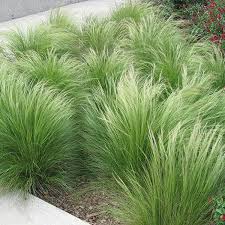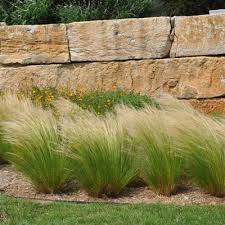Feather grass, also known as stipa or needle grass, is a really pretty kind of grass that looks great in gardens and open areas. It’s like a delicate dancer, swaying in the wind with its soft, feathery plumes and thin, curvy leaves.
Feather grass comes from different parts of the world, like North America, Europe, and Asia. It’s a tough plant that can handle different types of soil and weather, which makes it a good choice for people who are new to gardening or those who have done it for a while.
Imagine feather grass growing in small groups, like a little team. The leaves are thin and droopy, making them look like a flowing fountain. In the summer, the grass grows these neat spikes that have fluffy feathers on top. The feathers can be gold or silver-white, like a fancy decoration. And guess what? These feathery things stick around even in the fall, making the place look interesting and cool.
Here’s another cool thing about feather grass – it doesn’t need a lot of water. Once it’s settled in the ground, you don’t have to water it too much, which is great because it’s good for saving water. Plus, bugs and diseases don’t bother it much, so you don’t have to spray yucky stuff on it.
Putting feather grass in your outdoor area is easy. You can plant it along the edge, in rock gardens, or mix it up with other plants that look nice beside it. It’s like making a team of plants that get along and look awesome together.
Taking care of feather grass is simple. Every year, when winter is almost over, you can trim off the old parts to make space for new ones. And if your feather grass gets big and crowded after a few years, you can split it into smaller groups. It’s like giving your grass some extra room to spread out and be happy.
In the end, feather grass is a super pretty and flexible kind of grass that makes any outdoor spot look better. It’s like a graceful dancer that’s always there, bringing a peaceful feeling and a touch of nature’s beauty to your garden or yard, no matter the season.
Read Also:“Earthen Pond vs Concrete Pond” Which one is your Recommendation?
Complete Growing and Care Guide of Feather Grass

Feather grass, also known as stipa or needle grass, is a wonderful addition to any garden or landscape. Its graceful appearance and low-maintenance nature make it a popular choice for both beginners and experienced gardeners. Follow this comprehensive guide to successfully grow and care for feather grass.
1. Choosing the Right Location: Select a spot that receives full to partial sunlight. Feather grass prefers well-draining soil and can tolerate a variety of soil types, including sandy or rocky soils. Make sure the chosen area allows enough space for the grass to grow and sway freely.
2. Planting: Plant feather grass in early spring or early fall. Dig a hole slightly larger than the root ball and place the grass at the same depth it was in its container. Space multiple plants about 1 to 2 feet apart, depending on the variety.
3. Watering: Water the newly planted feather grass regularly to help establish its root system. Once established, feather grass is drought-tolerant and requires minimal watering. Water deeply but infrequently, allowing the soil to dry out between waterings.
4. Mulching: Apply a layer of organic mulch, such as straw or wood chips, around the base of the grass to help retain moisture and suppress weed growth. Be sure to keep the mulch away from the crown of the plant.
5. Pruning and Maintenance: In late winter or early spring, trim back the old foliage to about 6 inches above the ground. This allows new growth to emerge without being obstructed by the old leaves. Every few years, divide mature clumps to promote healthy growth and prevent overcrowding.
6. Feeding: Feather grass generally doesn’t require heavy fertilization. A light application of a balanced, slow-release fertilizer in early spring can provide the grass with necessary nutrients. Avoid excessive nitrogen, as it can lead to overly lush growth.
7. Pests and Diseases: Feather grass is relatively resistant to pests and diseases. However, keep an eye out for aphids, grasshoppers, or fungal issues during periods of high humidity. Treat any problems promptly with appropriate organic solutions.
8. Winter Care: Feather grass is hardy and can withstand cold temperatures. Leave the foliage intact during the winter to provide some protection to the plant’s base. In spring, trim back the old growth to allow new shoots to emerge.
9. Landscaping Ideas: Feather grass looks stunning when planted in groups or as a border along walkways and garden beds. It can also be combined with other ornamental grasses, flowering perennials, and shrubs to create a dynamic and visually appealing landscape.
10. Sustainability: Feather grass is an eco-friendly choice due to its low water requirements and resistance to pests. By planting feather grass, you’re contributing to a more sustainable and water-efficient garden.
In addition, feather grass is a versatile and enchanting grass that adds beauty and elegance to any outdoor space. With proper care and attention, you can enjoy its graceful presence and feathery plumes year after year.
Read Also: The Ideal depth of an Earthen Fish Pond
Mexican Feather Grass

Mexican feather grass is like a living masterpiece in your garden. It’s a special kind of grass that sways gently in the breeze, creating a dance of elegance and charm. This grass is native to Mexico and the southwestern United States, where it adds a touch of natural wonder to the landscape.
With its slender and delicate green blades, Mexican feather grass looks like a soft, flowing waterfall frozen in time. It’s like nature’s art, capturing movement and grace in a single plant. During the warmer months, this grass sends up tall stems adorned with feathery golden flowers that catch the sunlight and shimmer like gold.
One of the magical things about Mexican feather grass is how it changes with the seasons. In the spring and summer, it’s alive and vibrant, moving with every whisper of wind. As fall arrives, it transforms into a golden wonderland, with its feathery flowers turning a warm and inviting hue. Even in the winter, this grass has a unique beauty, adding texture and interest to the garden.
Growing Mexican feather grass is a joy because it’s quite easy to take care of. Choose a sunny spot in your garden with well-draining soil. Plant the grass in the early spring, and give it a little water to help it settle in. Once it’s established, Mexican feather grass is quite independent and doesn’t need much attention. It’s like a self-sufficient artist, creating its masterpiece without much fuss.
Remember, though, that Mexican feather grass can be a little shy in colder climates. It might need a bit of extra care during the winter to keep it cozy and safe. Trimming it back in late winter or early spring can help it grow strong and beautiful when the warmer weather returns.
Whether you’re creating a naturalistic garden, a wild meadow, or even a little corner of green on your balcony, Mexican feather grass is a wonderful choice. It’s a reminder of the beauty and wonder that nature offers, a living testament to the artistry of the earth. So, bring a touch of Mexico’s enchantment to your space with this graceful and captivating grass – Mexican feather grass.
Read Also: What is some advantages of solar energy?
